Art & Exhibitions
David Ebony’s Top 10 New York Gallery Shows for October
Don't miss Brigid Berlin, Enoc Perez, and Isa Genzken.
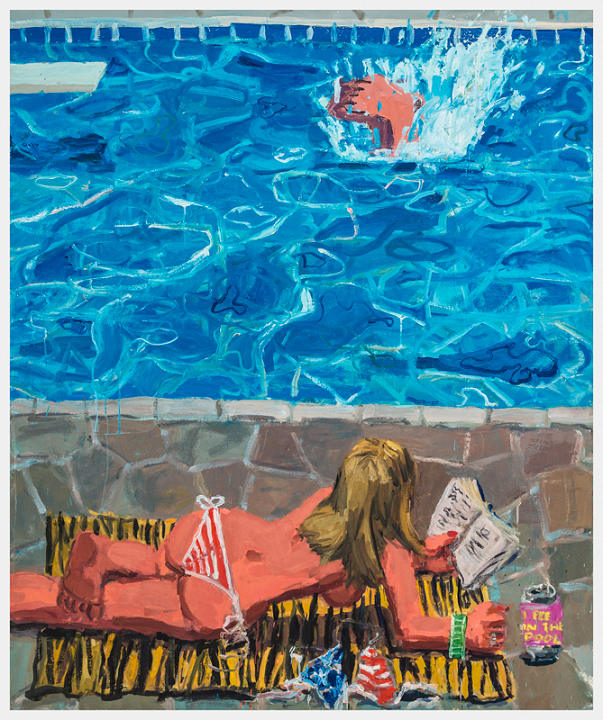
Don't miss Brigid Berlin, Enoc Perez, and Isa Genzken.

David Ebony

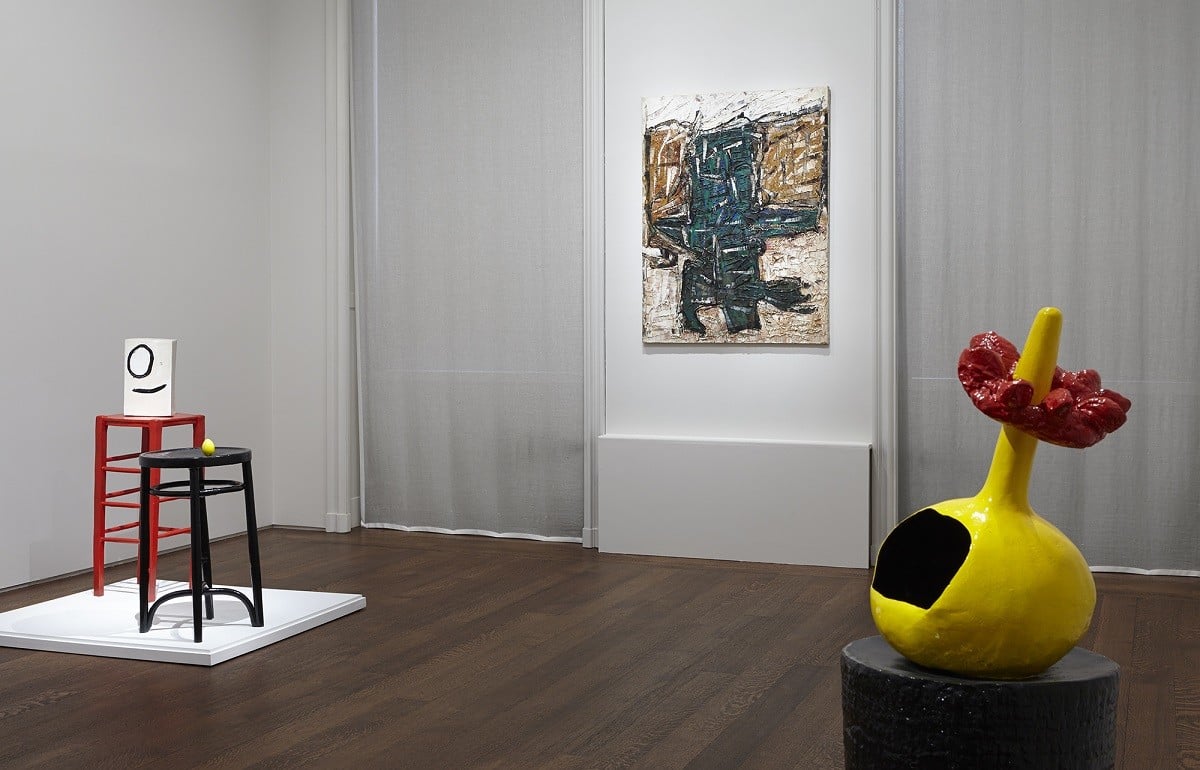
Installation view, “Riopelle and Miró: Color,” 2015.
Photo: Courtesy Acquavella Galleries.
1. Jean-Paul Riopelle and Joan Miró at Acquavella, through December 11
This two-person show, “Color,” featuring works by Canada’s best known post-war painter, Jean-Paul Riopelle, and the Surrealist pioneer Joan Miró, at first seems like a strange pairing. Riopelle’s highly textured abstract canvases, marrying American Abstract Expressionism with European Tachisme, might appear to be incompatible with Miró’s playful personages in 3D. In fact, there is surprising thematic cohesiveness in works by the duo, and this unique fusion—the first show of its kind—contains a great deal of energy as well as historical depth.
When Riopelle (1923-2002) left Montreal and relocated to Paris in 1946, he quickly fell in with the Surrealist group, just then reconvening in the aftermath of the war. Thirty years his senior, Miró (1893-1983) befriended the young Canadian, and became for him a kind of father figure and mentor. Later, the two shared a studio in the south of France, and when Miró decided to focus on sculpture, in the 1960s, he worked in a foundry outside of Paris that was partly owned by Riopelle at the time, where the bronzes in this show were produced. Miró’s large-scale, brightly hued works, such as Personage (1967), and Monsieur et Madame (1969), made of cast found objects, like bar stools and drain pipes, are humorous figures. In Miró’s Surrealist visual language, they might be regarded as attentive gallery goers, viewing Riopelle’s large paintings of the same period, such as Dans le jardin (1962), and Festin (1968), whose hyper-energetic surfaces suggest an infinite space.
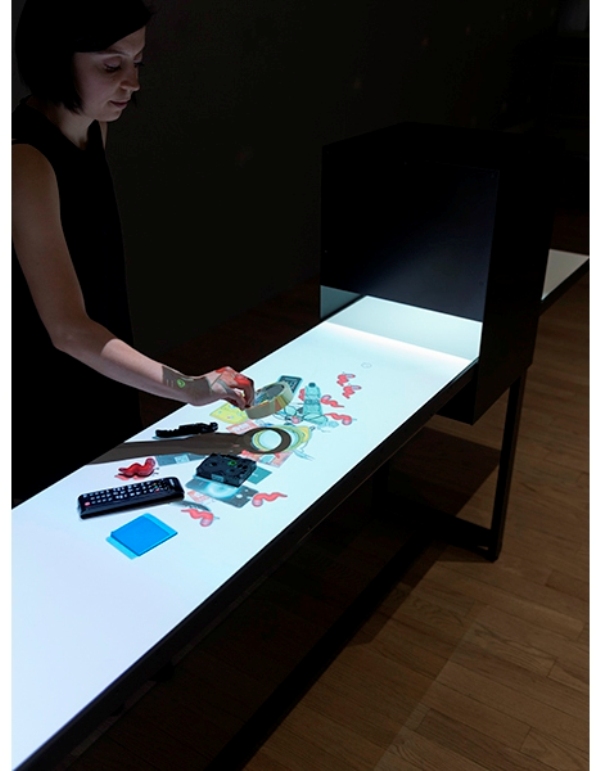
Rafael Lozano-Hemmer, Please Empty Your Pockets, 2010.
Photo: Courtesy bitforms gallery
2. Rafael Lozano-Hemmer at bitforms, through November 1
Electronic art is often dazzling, but sometimes, when the initial impact wears off, the work can seem superficial and gimmicky. And yesterday’s stunning technology inevitably gets ushered into tomorrow’s realm of nostalgia; or worse, it’s forgotten altogether. Over the past decade or so, Mexican-born artist Rafael Lozano-Hemmer has become a master of the genre, not simply because of his technical wizardry, which is certainly awe-inspiring, but because of the way he connects his work to societal concerns, and current events, as well as to recent art history. In each of his exhibitions, he demonstrates a special affinity to the work of conceptualists and installation artists, such as James Turrell, Robert Irwin, and especially Latin American greats like Hélio Oiticica, Lydia Clark, and Cildo Meireles.
This compact and unforgettable show at bitforms, “Lapsus Lumen,” roughly translated from the Latin as “broken light,” features a number of classic Lozano-Hemmer pieces as well as several new installations. In the exhibition, the artist touches upon hot-button issues of surveillance and identity. Many of the works beg the question as to what extent are we being controlled by technology. The George Orwell homage 1984×1984 (2014), for instance, is an interactive computerized display consisting of a large screen packed with thousands of flashing home addresses scanned by Google from doors of buildings around the world. Motion sensors in the gallery respond to visitors approaching the screen, who see that their silhouettes have been interjected into the flashing panorama.
One of the most fascinating pieces here, Please Empty Your Pockets (2010), encompasses a white conveyor belt rigged with computerized scanners, similar to those at airport check points. Visitors are invited to empty their pockets and place the items on the belt. After passing through the scanner, the items can be removed from the belt. A digital image doppelganger of each piece, preserved for posterity, appears on the spot where the item had just been placed. In this exhilarating yet chilling work, as in many pieces on view, Lozano-Hemmer warns of new possibilities for technology’s ever-evolving invasiveness.
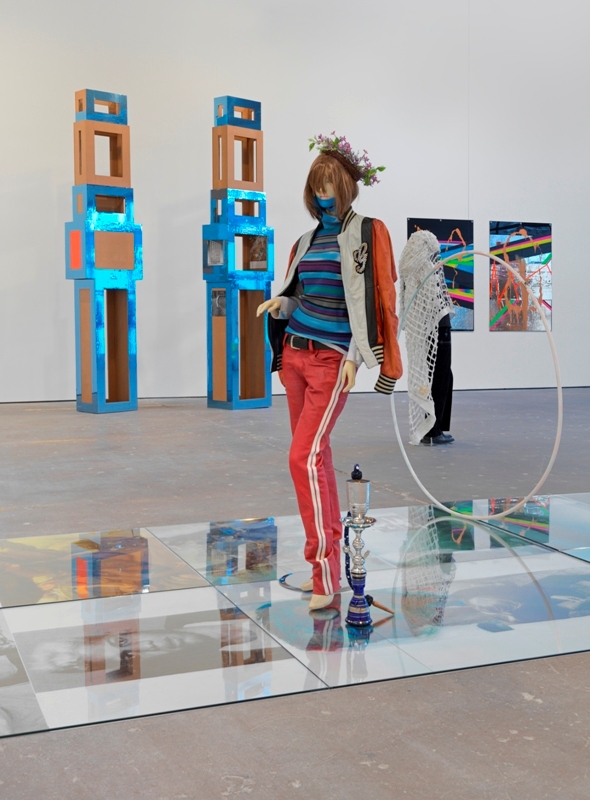
Installation view, Isa Genzken, 2015.
Photo: Courtesy David Zwirner Gallery.
3. Isa Genzken, at David Zwirner, through October 31
This show of recent sculptures, installations and paintings by German artist Isa Genzken is as challenging as it is enthralling. On view are some arresting pieces from her ongoing “Schauspieler (Actors)” series, in which carefully positioned mannequins, many of them dressed in selections from the artist’s wardrobe, appear to play key rolls in a very quirky drama. There are also recent paintings in Day-Glo colors, and towering architectonic abstract sculptures, which are among her best works to date. The “actors” are especially compelling. Arranged in a focused tableau, they appear to convey an allegorical tale, often with political overtones. One figure in a pointed hood, for instance, recalls an Abu Ghraib prisoner. Despite the abject materials and ominous comportment of some of the figures, there’s a hint of stylish glamour to the proceedings.
The exhibition is something of a revelation for me, since I was not among the large chorus of critics singing the praises of Genzken’s career retrospective at the Museum of Modern Art in 2013. I appreciated her early sculptural works in a minimalist vein, and other pieces of the 1980s that were permeated with a feeling of architectural power tempered by fragile elegance. But the gaudy, found-object assemblage sculptures that she prolifically churned out in more recent years seemed unfocused, and left me cold. But in this show, her world-view is clear and potent. Genzken apparently takes her cues from street art. The exhibition’s full impact is most evident on sunny and balmy autumn days, when this warehouse-like exhibition space is open to the street. The effervescent pieces beckon everyone in.
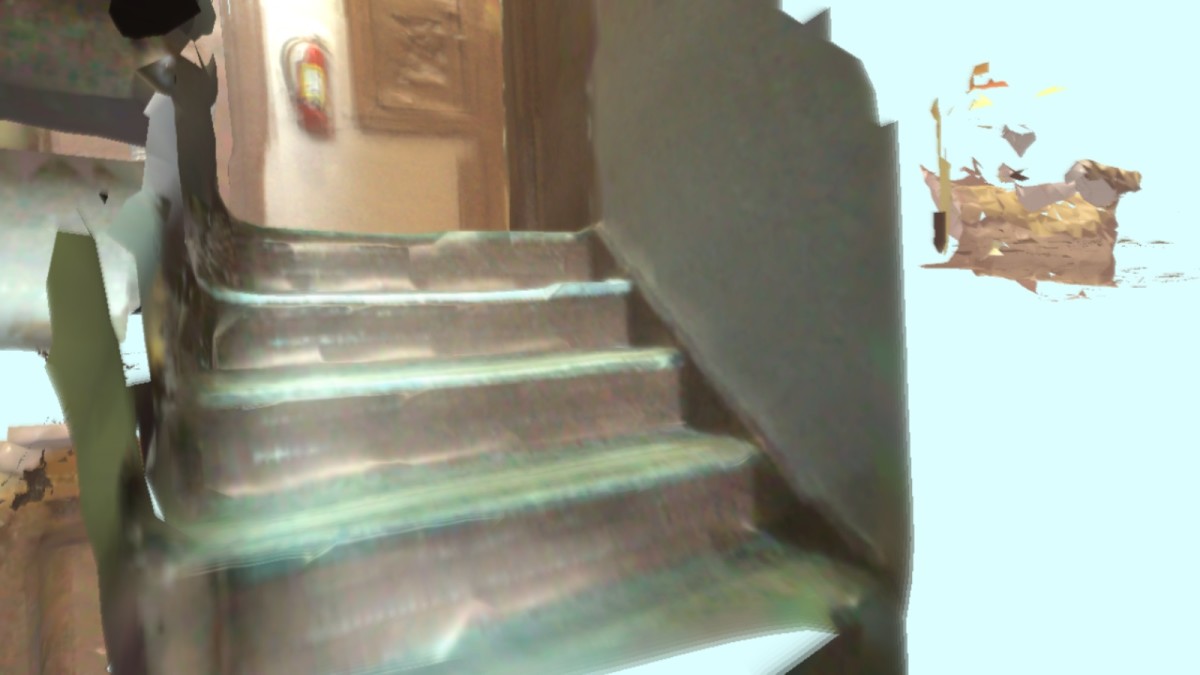
Rachel Rossin, I Came And Went As A Ghost Hand (virtual reality still), 2015,
Photo Courtesy Zieher Smith & Horton.
4. Rachel Rossin, at Zieher Smith & Horton, through November 14
The premise for “Lossy,” an exhibition of recent paintings, and virtual-reality work by Florida-born, New York-based artist Rachel Rossin, is, as the title suggests, loss or depreciation of energy. The term applies especially to electronic data, and the second law of thermodynamics, signs of entropy. In her work, Rossin depicts a decaying world, with imploding landscapes, such as the painting Substrate, decomposing abstracted figures, as in Self Portrait, and melting still lifes, including Roses in a Vase. Rossin’s paintings share something with Glenn Brown’s particular brand of melancholia. It is an exquisitely realized vision, both forlorn and thrilling.
The show’s centerpiece, I Came And Went As A Ghost Hand, is a dizzying 3D extravaganza accessible by means of two Oculus Rift headsets, suspended from the ceiling by cables and placed on sculpture stands. The virtual reality work offers what the show’s press release describes as a transmogrified environment. But it is actually a gorgeous and mesmerizing place of undulating landscapes, and expansive interior spaces, all digital images based on the artist’s studio, environs, and paintings. It’s just a 2 ½- minute trip, but it’s hard to pull yourself out of Rossin’s dream world. When you do, it’s not a let-down to re-explore the illusionistic spaces within the two-dimensional confines of her paintings. As an experiential endeavor, this exhibition represents the most successful merger of painting and virtual reality I have seen.
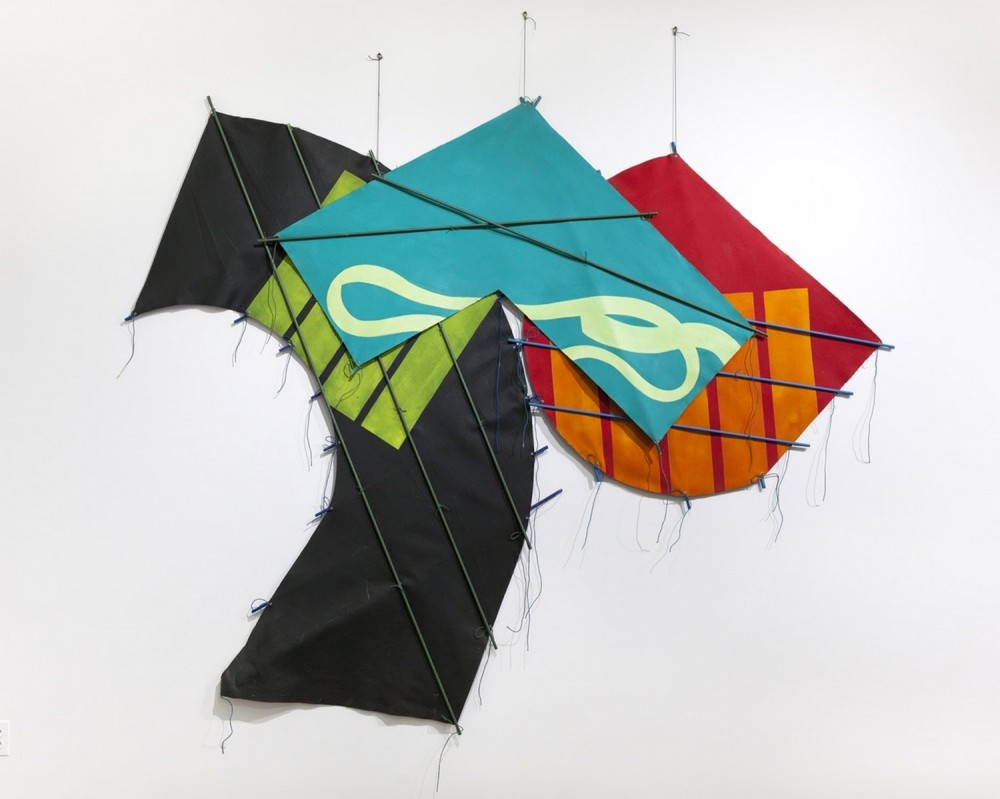
Richard Smith, Mask, 1983,
Photo: Courtesy Flowers Gallery, New York.
5. Richard Smith, at Flowers, through November 14
“Kite Paintings” focuses on one of Richard Smith’s most radical experiments in painting of the 1970s and 80s. It is the first New York show devoted to these works since the 1970s. Smith first made a splash in the international art world of the late 1950s and early 60s as a pioneer of British Pop, with shaped canvases and abstract compositions in searing hues and simple forms borrowed from pop culture’s language of advertising logos, consumer product design, cinema, and television. Smith continues to make vibrant, abstract paintings today; he has lived in New York City since the late 70s, although his association with contemporary British art has remained steadfast and unshakable.
One of Smith’s most important contributions to painting was to free it from its two-dimensional limitations. In the 1960s, his shaped canvases encroached on the realm of sculpture, as he helped redefine what a painting could or could not be. The ‘Kites,’ as the works are known, feature overlapping panels of cloth, painted with simple shapes and vibrant colors, and strung together with bits of string. The works indeed recall various types of kites, and lend the discipline of painting itself the hitherto unheard of possibility of aerodynamics, at least theoretically. Bridging the realms of painting and sculpture, the works—like the epically-scaled Major Battle (1984), with its muscular arrangement of blue, green, and red panels—soar. One of the most poetic works, Mask (1983), featuring a dark curving shape overlain with a chevron panel of glowing turquoise, protrudes several feet into the gallery space. There’s a great deal of tension and movement in this piece, and in all of the works in this luminous show.
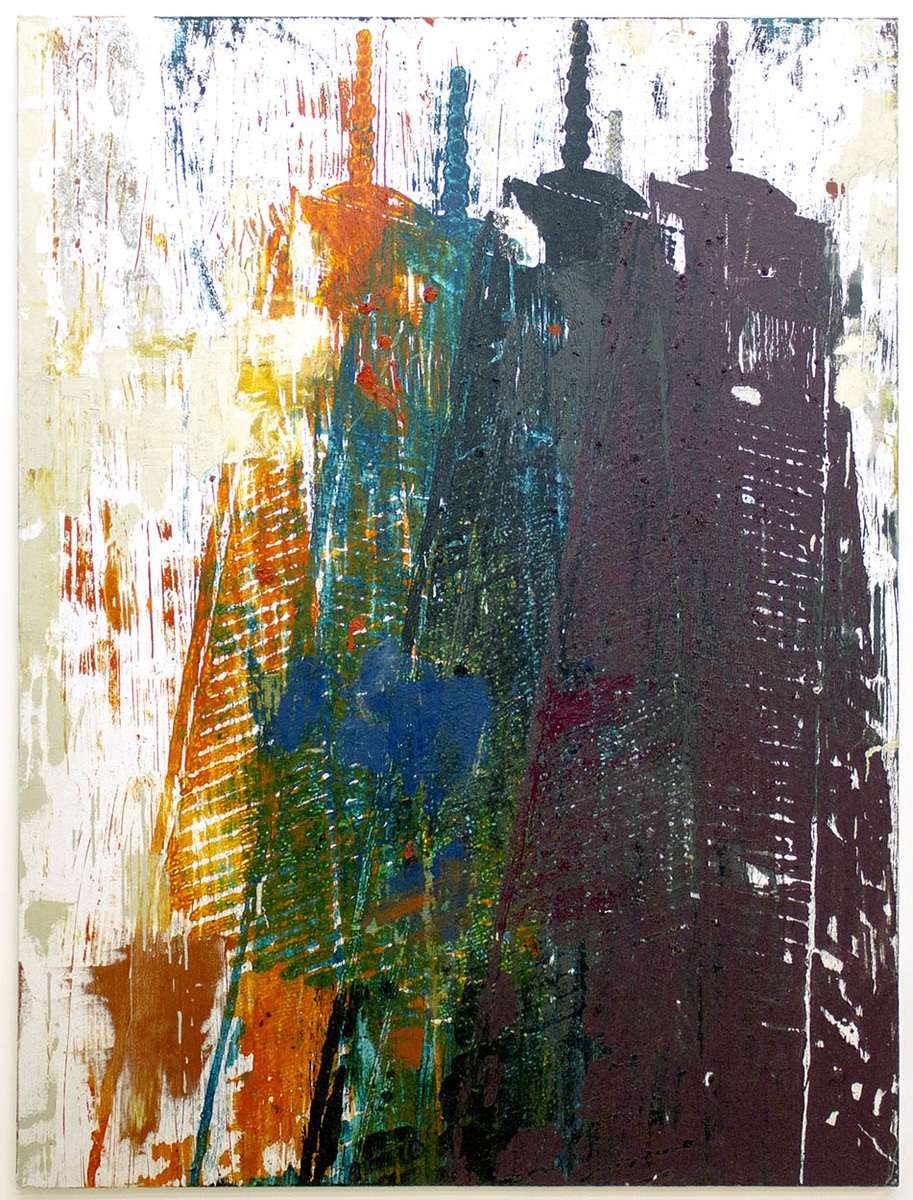
Enoc Perez, One World Trade Center, 2015.
Photo: Courtesy Peter Blum Gallery.
6. Enoc Perez, at Peter Blum, through November 14
Someone had to do it—that is, produce the first iconic paintings of the brand new “Freedom Tower.” It’s a good thing that it’s a painter of Enoc Perez’s stature and talent. Known for his painstaking renderings of storied structures like the Marina Towers in Chicago, or the Fountainebleau Hotel in Miami, Perez takes a cue from Andy Warhol in this haunting series of large canvases (80 by 60 inches). Featuring subtle variations on a single image, One World Trade Center, most of these works are set against shimmering silver-leaf backgrounds.
The ten works lining the walls of the gallery deliver a singular punch, echoing the monolithic presence of the Skidmore, Owings and Merrill-designed skyscraper itself. In the series, the Puerto Rico-born, New York painter seems to have borrowed Warhol’s silkscreen stencil technique of overlapping, identical images. Perez’s work, however, results from a painstaking transfer process involving oil-stick drawing imprints on the canvases, and countless layers of oil pigment. This series elicits many emotional responses. Like architectural ghosts, the multiple images conjure the Twin Towers, conveying a feeling of loss and foreboding. Another way to view the series, with its reference to Warhol’s “factory,” is as an homage to New York City itself, a paean to the ever-vibrant, indestructible Big Apple.
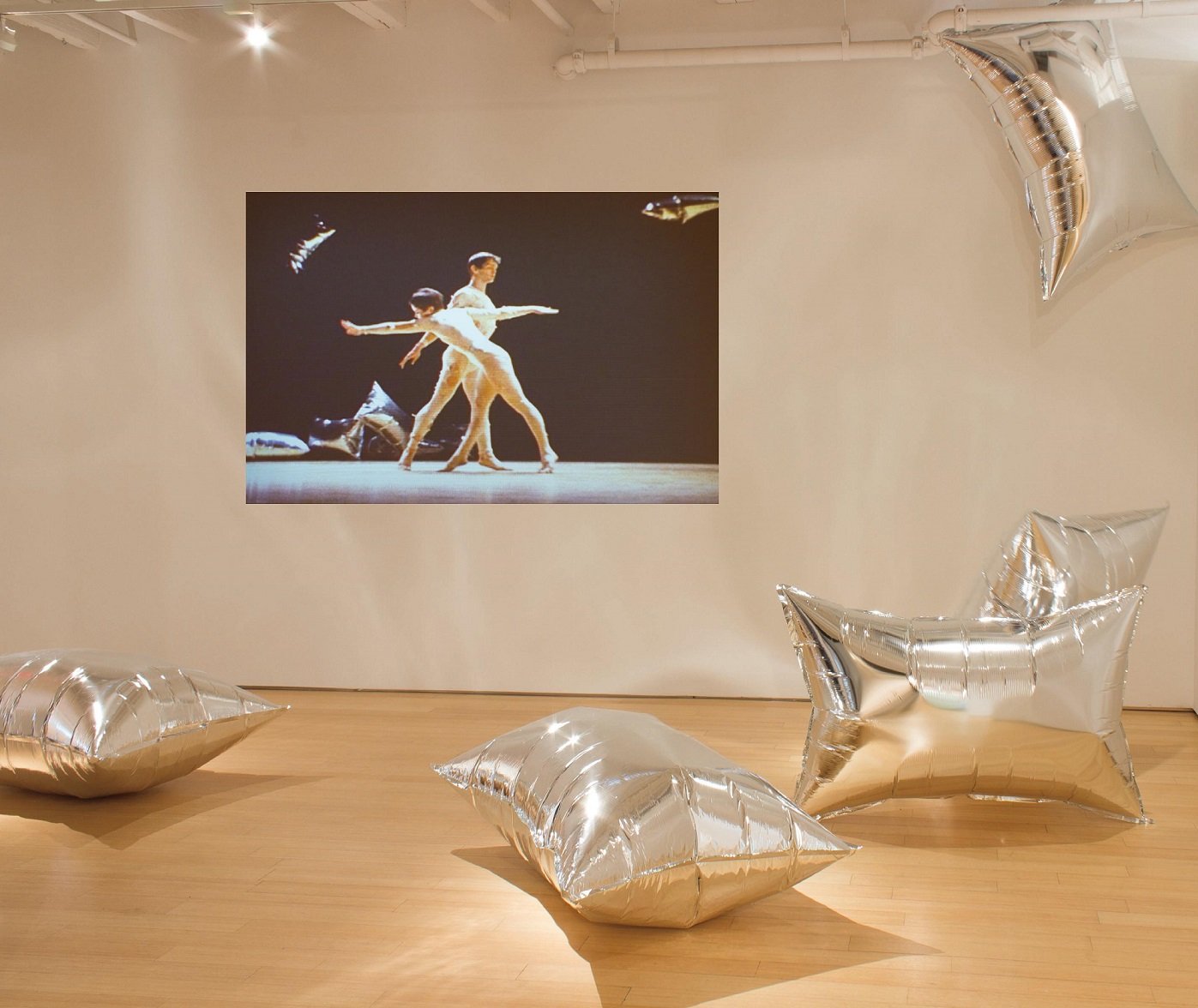
Installation view, “Where Sculpture and Dance Meet,” 2015.
Photo: Courtesy Loretta Howard Gallery.
7. Where Sculpture and Dance Meet, at Loretta Howard, through October 31
When avant-garde artists like Andy Warhol, Robert Morris, Donald Judd, and Sol LeWitt re-imagined sculpture in the early 1960s, in terms of spare forms and repeated minimalist shapes in room-size installations, they inevitably implicated the movement of the viewer through that space. The circulation of visitors through an exhibition, the interaction of the human body with sculptural forms, and the temporal aspects of performance, are all major concerns of the avant-garde today. “Where Sculpture and Dance Meet: Minimalism from 1961 to 1979,” goes to the source of these issues by exploring early interactions and collaborations of avant-garde choreographers and sculptors.
On view are prime examples of sculptural works by artists such as Warhol, Judd, and LeWitt, paired with videos of groundbreaking dance performances by Trisha Brown, Lucinda Childs, Simone Forti, and others. At the show’s entrance, a grouping of Warhol’s inflatable Silver Clouds (1966) hovers near a wall on which appears a video of Merce Cunningham’s 1968 dance piece, Rainforest. The choreographer used Warhol’s glittery airborne pillows as a set. One of the most enthralling parts of the exhibition centers on a 1979 collaboration of Lucinda Childs, Sol LeWitt and Philip Glass, which appears in a video projection, while a classic, white minimalist structure of the period by LeWitt commands the actual gallery space. Co-curated by Wendy Perron and Julie Martin, in collaboration with Loretta Howard, this handsome, museum-quality presentation is as engaging as it is informative.
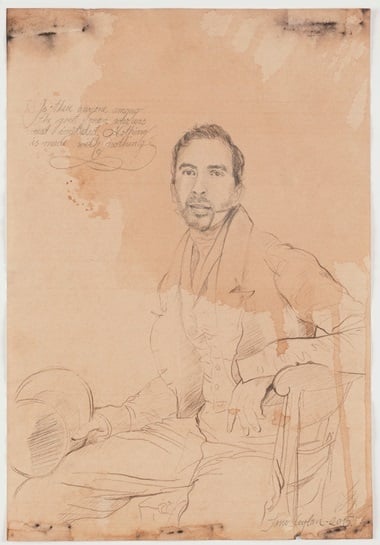
Taner Ceylan, Self Portrait 9, , 2015.
Photo: Courtesy Paul Kasmin Gallery.
8. Taner Ceylan, at Paul Kasmin, through October 31
Painter Taner Ceylan is a controversial figure in his native Turkey, where he has been ostracized for his explicit homoerotic images of the 1990s. In more recent works, he has tempered the sexual overtones a bit, but the conceptual depth and technical acumen of the work remain strong. For this show of two oil paintings and a series of elegant drawings, Ceylan was inspired by Oscar Wilde’s quote that “Every portrait that is painted with feeling is a portrait of the artist, not the sitter.” In the drawings on view, he replaces the portraits of well-known subjects by Jean-Auguste-Dominique Ingres, with his own face. Using antique paper, and an ultra-retro, old master drawing style, Celyan’s work should feel nostalgic, but it has an edgy quality that seems very much of-the-moment.
In his almost archeological explorations of work by artists of the past, Ceylan’s endeavor sometimes recalls Carlo Maria Mariani’s paintings of the 1970s and 80s, in which he reconstructed “lost” works, such as masterpieces by Albrecht Dürer, which are known only through literary evidence. Ceylan is currently engaged in a series titled, “Family Paintings,” which includes the brilliant and audacious centerpiece of this show. This meticulously crafted portrait in oil is based on one of Ingres last portraits, Princess de Broglie (1851-53), in the collection of the Metropolitan Museum of Art. In the new rendition—under Oscar Wilde’s spell—Ceylan has replaced the woman’s face with Ingres’s self-portrait. In an almost surrealist gesture, the princess’s head appears on a small canvas across the room.
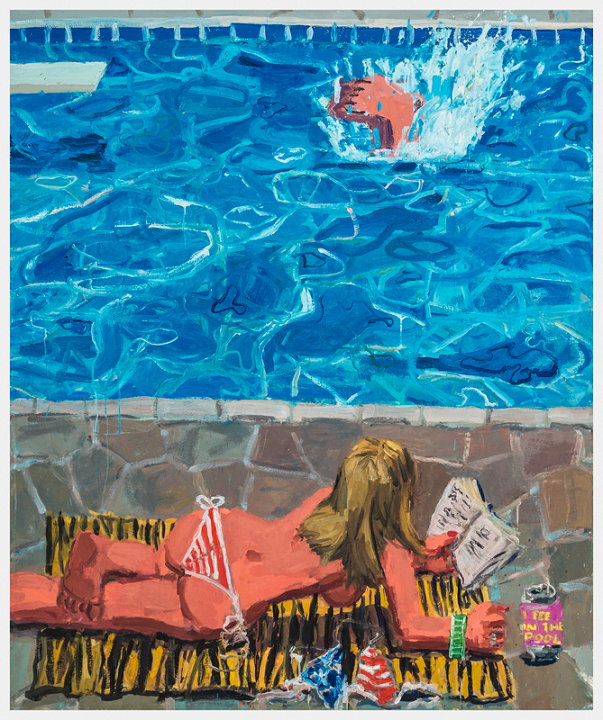
Todd Bienvenu, Adult Swim, 2015,
Photo: Courtesy Life on Mars.
9 Todd Bienvenu at Life on Mars, through November 8
“Exile on Bogart Street,” a Williamsburg, Brooklyn, revision of the Rolling Stones album title, is an appropriate name for this lively exhibition of new figurative paintings by Todd Bienvenu, which is filled with a kind of manic, rock ‘n’ roll frenzy, and street-smart urgency. The Arkansas-born, New York painter is clearly adept at the painterly flourishes of his expressionist predecessors, ranging from Max Beckmann, to Philip Guston, and Georg Baselitz. But to the genre Bienvenu adds a special flair, and a great deal of humor.
Adult Swim is a resplendent work, which shows an R. Crumb-style foot emerging from a swimming pool near the top of the composition. The lower portion of the canvas is occupied by a bikini-clad woman reading, with a nearby soda can label divulging her secret: “I pee in the pool.” It’s a silly gesture, for sure, but it doesn’t undermine the painterly conviction of the work. Similarly, Dick Truck shows a yellow moving van whose side has been tagged with the pink outline of a large penis. The sign of juvenile vandalism exalted in this painting may thwart any serious analysis of artistic aims, but that’s not the point. The artist is simply inviting viewers to come along for the ride.
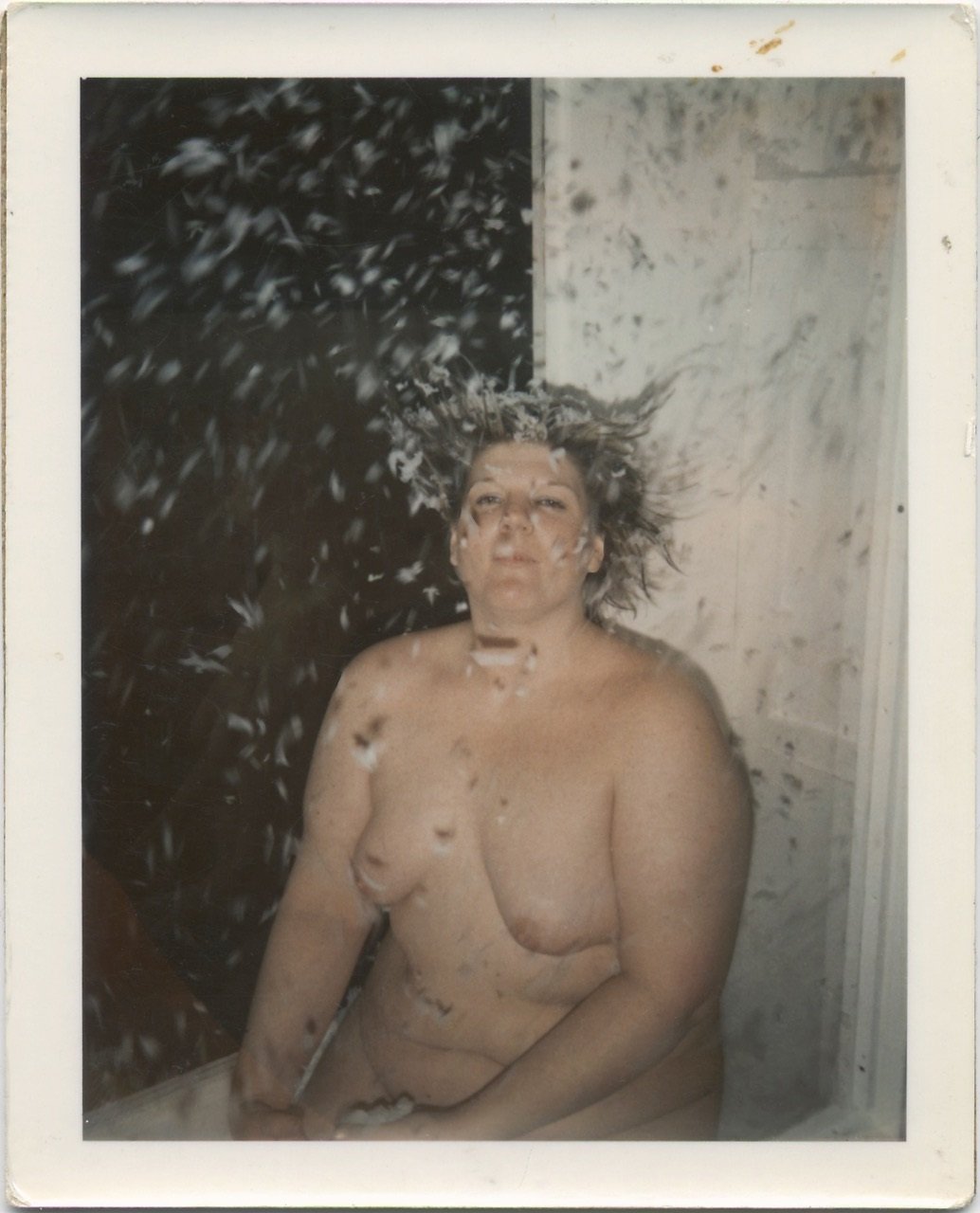
Brigid Berlin, Untitled (Self-Portrait with Wind Machine), ca. 1971-1973.
Photo: Courtesy Invisible-Exports.
10. Brigid Berlin, at Invisible-Exports, through November 15
A sometime Andy Warhol superstar, appearing in his early films like The Chelsea Girls, and later the star of a number of John Waters’s films, Brigid Berlin, aka Brigid Polk, is something of an underground living legend. She was a socialite who rebelled against her upper-class upbringing and found Warhol’s inner circle a refuge. Throughout the 1970s and into the 80s, she was Warhol’s trusted confidant and a valued employee of his multifaceted business enterprise. Her contribution to Warhol’s legacy is vast and long-recognized, but as an artist in her own right, she was practically unknown—until now.
Her own identity comes to the fore in “Brigid Berlin: It’s All About Me,” containing a large selection of her self-portrait Polaroids, a wealth of documentary material, and a wall filled with examples of her “tit paintings,” a series of colorful impressions of her breasts on watercolor paper, created mostly in the 1990s.
Permeating the gallery are sounds of audio recordings taken from Berlin’s collection of taped phone conversations with Warhol. Vitrines filled with photos, notebooks, and other archival items from the 1960s and onward, demonstrate how Berlin manically saved everything. The most appealing works are the Polaroids, many of them hand-tinted or manipulated, and double-exposed, such as the one in which she appears nude, withstanding the gale force of a wind machine. There is a wacky and endearing sense of humor consistently evident in Berlin’s retrospective self-appraisal.
David Ebony is a contributing editor of Art in America and a longtime contributor to artnet.